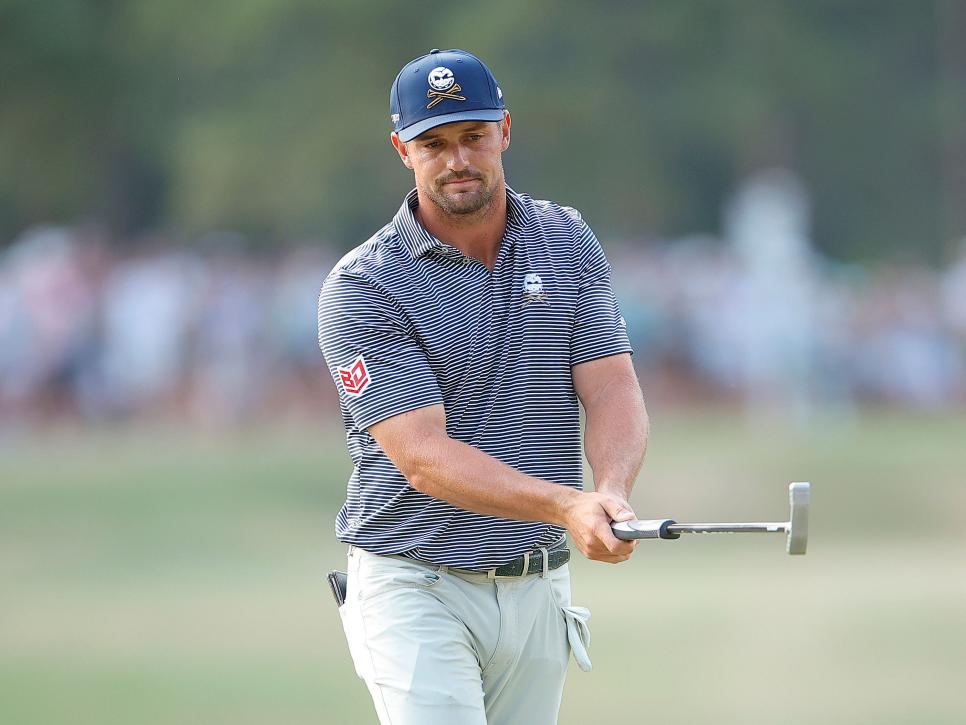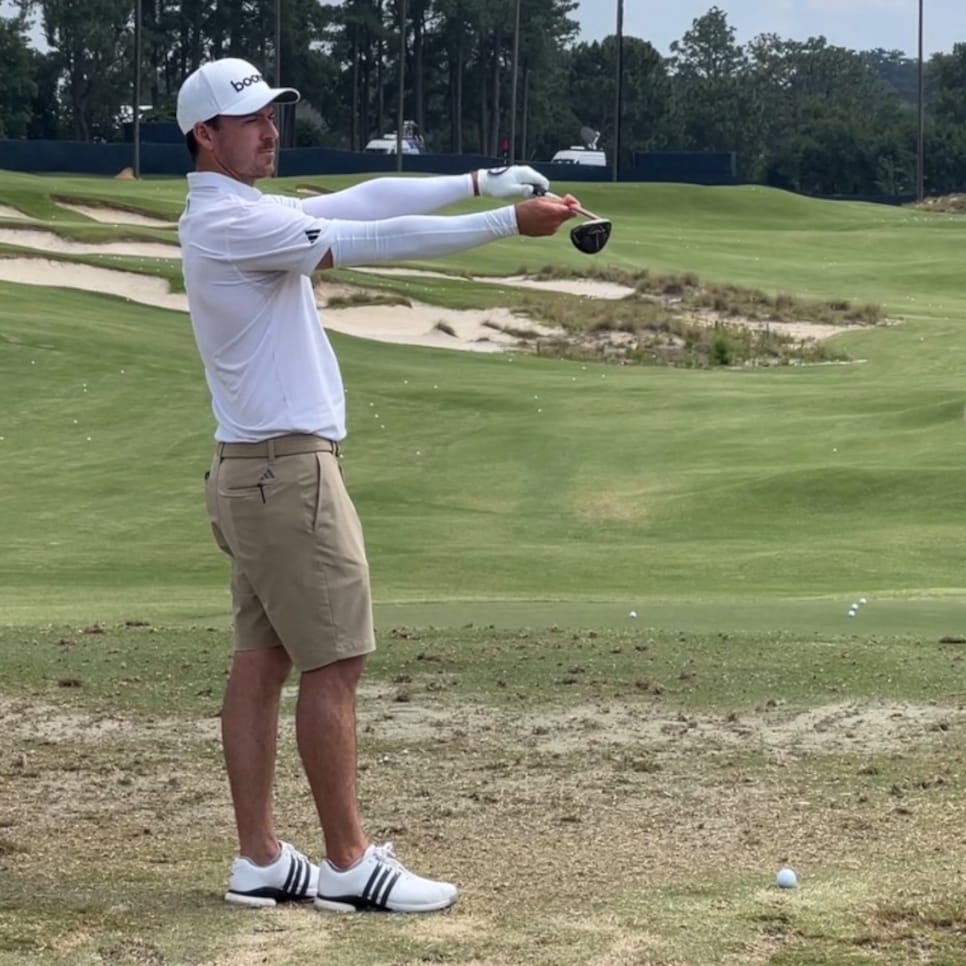[PHOTO: Gregory Shamus]
Bryson DeChambeau is at his best when he has a problem to solve. The solutions, usually, end up looking pretty strange. But the solutions always end up working.
It’s probably the thing I most admire about Bryson, and the thing the rest of us can learn the most from.
Bryson started his professional career as a shorter hitter, a sketchy putter, and an unimpressive wedge player. He was a serial under-performer as a result: in his first 21 events as a professional, he missed 11 cuts. After a T-2 finish at the 2016 Puerto Rico Open – his only top 10 finish since a year earlier – DeChambeau finished T-44 in his next start, then promptly missed another eight consecutive cuts. In his first 11 major starts as a professional, he notched exactly zero top-20s.
In some alternate universe where golf exists, Bryson DeChambeau is a middling tour player who eventually loses his card and ends up working at a driving range somewhere.
Instead, DeChambeau pushed his way towards a different destiny because somewhere along the way, he stopped caring about what other people thought about his game. He’s one of those players who doesn’t care how something looks, or what others think about how it looks. If it helps him, he does it. If it doesn’t, he doesn’t. There’s no sense of shame or embarrassment. To him, the only stupid thing is not doing something you think would help because you’re worried about looking weird.
It’s also a quality I find most endearing about the game itself. Golf is a humbling game that forces you to confront your own ego in a quest for improvement. Keep yourself honest: how much pride are you willing to swallow to get a little better?
1. Understand acceleration profiles
The garage in DeChambeau’s house is littered with prototype putters of every variation you can imagine. Long putters; short putters; side-saddle putters; light putters; heavy putters; one partially 3D-printed putter he likes the look of but didn’t put in play because he couldn’t scoop the ball easily with it.
One of those it-looks-weird-but-I-don’t-care areas for DeChambeau is his putting stroke. He used to be a pretty bad putter, even when he was a very good amateur golfer. But through radical trial and error, he landed upon a system. It works for him, and there’s some stuff we can learn, too.
There are lots of parts of DeChambeau’s putting system, but one of the most interesting and underrated is his extremely detailed approach to speed control, which is probably the most important part of putting.
Before every round DeChambeau places a ruler by his ball, and a tee 30 feet away. His standard is something like 10 inches: Meaning that when he takes a 10-inch backstroke, with a through-stroke that isn’t either accelerating or decelerating severely (he calls that his “acceleration profile”, which he checks using a Foresight QuadMAX), he knows the ball will roll 30 feet.

But if that day, he makes a backstroke that’s 10 inches long and watches the ball roll 33 feet, he knows the greens are 10 percent faster that day than his standard, so he adjusts his read and speed on every putt accordingly. If the ball rolls 36 feet, he knows they’re 20 percent faster.
Our brains work best when we give it parameters, and give stable reference points to make judgments from. That’s what DeChambeau does every day. The rest of us obviously aren’t going to go to the same degree, but we can adopt the same idea: starting every round hitting the same length putt, monitoring how far we’re taking the putter back and how fast it’s moving through, and paying attention to the result.
US Open 2024: Why does Bryson DeChambeau hover his driver like that?
2. Beware of the small muscles
Have you ever noticed that the grip on DeChambeau’s putter is upside down? That’s because he rotates his left arm as far left as it will go, then grips the putter. It means the palm of his left hand is facing almost directly out in front, a near-180-degree difference than the way most golfers grip their putter with their left hand – that’s why his grip is on backwards.
Bryson’s backwards grip quite literally locks his left arm so far left, that he can’t move it any more left.
“There’s so much range of motion in all these little muscles in the hands and wrists and arms,” he told me once. “I don’t want any of that.”
His grip makes pulling putts, he says, basically impossible. I don’t know if it’s true, but it’s interesting that the man who Bryson beat at Pinehurst pulled his crucial two-and-a-half-footer left of the cup on the 70th hole. The small muscles appeared to take over at exactly the wrong moment.

3. One miss is fine, two is killer
Speaking of pulls I must admit: watching Rory McIlroy on the range on Saturday evening before his final round, it didn’t seem like I was watching a man who was about to win a major championship.
Rory was frustrated at a variety of misses late in his third round, which continued into his final round.
“The miss on 16 [left] was a reaction to the miss on 15 [right]. The miss on 17 [right] was a reaction to the miss on 16 [left],” he said on the range.
Rory’s most common miss was high and right, which was annoying but, ultimately, fine. The wheels ultimately came off when he started reacting to that right miss with a panicky left miss. That’s what he was so frustrated about on the range on Saturday.
Keep an eye on that high right miss from Rory. It's been lingering all week.
It happens when he gets the club a little stuck behind him. He can get away with it with his driver, but less with his irons.
Happened on 15 and 17 Saturday, and on the 4th Sunday. pic.twitter.com/OhdTaaEZnU
— LKD (@LukeKerrDineen) June 16, 2024
Rory knows this, but the oldest cliché in golf is a true one: golf is a game of misses. One annoying, even persistent, miss isn’t the enemy. Rory built a two-shot lead on the back-nine with that lingering right miss. It’s when you start over-correcting for that miss in a way that sends the ball in every direction that the downward slide begins.
4. Perfection doesn’t exist – for anyone
Along those lines, I love this quote from Ludvig Aberg. When the rest of us see Aberg, we see a tall, handsome man with a perfect golf swing. Aberg is wiser enough to know that’s not true. Perfection? That’s a myth. It’s a game of misses when you’re on the course, and a game of tendency-management whenever you’re not.
“As a golfer, you’re always going to have tendencies. You’re always going to have something in your swing that you’re going to work on,” he said. “That’s the case for me, as well. We worked on those tendencies. Sometimes it just shows up. You can’t be perfect all the time.”
5. Tee it high – even with irons?
My week at Pinehurst started on Monday, when I bumped into Golf Channel’s Brandel Chamblee. Chamblee was in the booth for NBC all week, so he was out early scouting Monday’s star-studded practice round of Tiger Woods, Justin Thomas, Rickie Fowler and Jordan Spieth when he pointed out something interesting.
“Look how high Tiger tees the ball with his irons,” he said.
It was right. JT’s ball was nearly flush to the ground on the par-3 17th. Tiger’s was probably a quarter of an inch off the turf.
“It gives him a few extra degrees of launch,” Chamblee said, “and a few feet higher ball flight, so he can hold greens these firm a little better.”
Tiger’s ball did just that. It sailed into the air, and came down soft onto the back portion of the surface.
It’s the details that matter in the US Open, when the margins between good and bad are at their thinnest. Tiger doesn’t have the physical tools to match anymore, but his mind remains as sharp as ever.
6. An A+ piece of advice
I was extremely delighted and slightly jealous that my colleague Chris Powers had the best game-improvement tweet of US Open week. I truly can’t say it any better myself…
It is so hilarious to me how grip conscious the No. 1 player in the world is and yet still every chopper I play with death grips it like a baseball bat and wonders why they hit a 90-yard slice pic.twitter.com/ALJfjseFJ2
— Christopher Powers (@CPowers14) June 12, 2024
7. Give yourself the right kind of feedback
What would you do if you were about to play a US Open you were extremely unprepared for? I would probably start playing a lot of golf.
Robert Rock, the 47-year-old who came out of retirement to unexpectedly qualify for the US Open, did exactly the opposite. And it was actually kind of genius.
Rock spent his weeks leading up to Pinehurst hitting balls into a net. He played just a handful of holes over those weeks, and then went back to his net afterwards. He used a video camera to film his swing, but the net was his way of divorcing himself from his own expectations. It’s hard to stress about where the ball is going when you literally don’t know where the ball is going.
Instead, Rock’s goal was simply to improve his technique, knowing that was his path to his best golf. To focus on the process – the one thing we can control, as golfers – and less on the result, which we can’t.
8. The kings of the golf swing
Every other week of the year, The Cradle is an incredible par-3 course that players travel across the globe to enjoy. During US Open week, it’s a driving range for pros. A super-nice driving range, but on Thursday afternoon Max Grayserman intentionally found the very worst part of it. Squirrelled away in the far right corner, he spent about an hour hitting golf balls on an uneven patch of sand.

Coincidentally, on the other side of the range, Canadian Nick Taylor was holding his club out in front of him like a samurai sword before each shot.

The two things players and teachers care most about is where the clubhead is hitting the ground, and where the clubface is pointing when it hits the ball. That’s what Taylor and Grayserman were doing:
- Taylor was holding his club that way to create a sense of awareness between the back of his left hand and the clubface.
- Grayserman was hitting balls from the unforgiving sand to force himself to make crispy contact with the ball first.
Club before ground, face square at impact. Important stuff happens in between, of course, but those two are the kings of the golf swing. It’s funny how during the biggest weeks, you see players start to pay homage to that.

